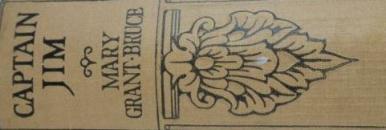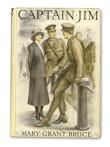Latest Issues
AbstractHistoryArchive Description
From the first instalment of the serialisation of the novel in THE SYDNEY MAIL, 30 July 1919:
"Our new serial, "Captain Jim," is by Mary Grant Bruce, whose reputation as a writer has been a steadily growing influence in Anglo-Australian literary circles for some years past. She achieved great success with children's stories, and we can name no Australian writer who has shown more sympathy with, and understanding of, the child mind. In her more mature work, of which "Captain Jim" is the latest example, Mrs. Bruce re-impresses the reader with her innate sense of literary style. Her appeal to the adult reader is a summons to the best that is in human nature, and yet there is no tawdry sentiment. Our serial is as breezy as the hills of Gippsland, where the talented authoress spent her early days. Quite recently she returned from England. "Captain Jim" is not a war story, although it is of the war period and gives glimpses of khaki. The major characters are Norah Linton, a big-hearted, fearless, Australian girl; David Linton, her father, an Australian sheep-farmer, from whom his family gels its vein of optimism and good humour; Captain Jim Linton, Norah's soldier brother, who has some exciting adventures; and Wally Meadows, Jim's soldier chum—a machine-gunner of typical Australian build and spirits. Of hardly less importance are Miss de Lisle, an English cook, and Allenby, an English disabled ex-sergeant, who proves a trump at the right time. The story rings with truth and scintillates with humour."
Publication Details of Only Known VersionEarliest 2 Known Versions of
Works about this Work
-
“Whichever and Whatever It Was” : Rendering War and Peace in Australian WWI Narratives
2016
single work
essay
— Appears in: Long Paddock , vol. 75 no. 3 2016; 'Australian narratives of World War I (WWI) reflect a different but characteristic commemoration of that event. While the best (to modern eyes) novels of WWI present a comprehensive picture of disillusionment, futility and waste, Australian stories proffer the view that the war was worthwhile, and that the sacrifices of the Anzacs were honourable and justified. In placing WWI as a salient marker denoting the origin of the nation, Australian texts diverge from the revered WWI canon’s convincing portrayal of the war as a symbol of civilisation’s demise. Even accepting this divergence, however, there is much in Australian narratives that amplifies the memorialisation of the war in Australian society.' (Introduction) -
She Rides Astride : Mateship, Morality and the Outback-Colonial Girl
2013
single work
criticism
— Appears in: Australasian Journal of Victorian Studies , vol. 18 no. 1 2013; (p. 28-39)'This article focuses on the representation of girlhood, gender and mateship particular to Australia, and to a lesser extent New Zealand, within the context of an emerging nationalism, social change and political upheaval. In it, I apply an illustrator’s perspective to interrogating the cultural significance of Mary Grant Bruce’s iconic outback heroine, Norah of Billabong Station. By comparatively examining Norah’s sequential representation in the narrative text, and the illustrations produced by John MacFarlane, I argue Bruce and her little-known, and rarely discussed immigrant illustrator combined to create an ideal and national type that was counter to anything that had been created for colonial girl readers before.' (Author's abstract)
-
Britishness and Australian Popular Fiction : From the Mid-Nineteenth to the Mid-Twentieth Centuries
2012
single work
criticism
— Appears in: Sold by the Millions : Australia's Bestsellers 2012; (p. 46-66) 'The analysis offered here is [...], a panoptic perspective of the tangled skeins of literary imagination and imitation, gender and genre requirements, editorial control, market considerations and the sheer economics of the international book trade that knotted Australian popular literature into the cultural and economic fabric of the British empire.' (47) -
Attitudes to War in Australian Children's Literature
1994
single work
criticism
— Appears in: Papers : Explorations into Children's Literature , April vol. 5 no. 1 1994; (p. 34-48) O'Sullivan seeks to 'identify attitudes to war in Australian children's literature' in the period 1914-1994, noting in particular the movement from identification with Britain and the Empire in the early decades of this period to an affinity with Asia and the Pacific in the latter decades (34). The discussion begins with a literature review of Australian and overseas critical research in this field and then surveys a large number of (mainly Australian) novels with war as the central/pivotal theme. O'Sullivan concludes that there has been a change in attitudes to war in Australian children's literature, whereby 'once Australia was part of the British Empire and prepared to fight for that anywhere in the world, now multicultural Australia takes a broader view and sees herself as part of a global family' (47). -
Fiction
1919
single work
review
— Appears in: The Queenslander , 20 December 1919; (p. 3)
— Review of Camp Kiddies : A Story of Life on Railway Construction 1919 single work children's fiction ; Captain Jim 1919 single work children's fiction ; Brigid and the Cub 1919 single work novel
-
Fiction
1919
single work
review
— Appears in: The Queenslander , 20 December 1919; (p. 3)
— Review of Camp Kiddies : A Story of Life on Railway Construction 1919 single work children's fiction ; Captain Jim 1919 single work children's fiction ; Brigid and the Cub 1919 single work novel -
Britishness and Australian Popular Fiction : From the Mid-Nineteenth to the Mid-Twentieth Centuries
2012
single work
criticism
— Appears in: Sold by the Millions : Australia's Bestsellers 2012; (p. 46-66) 'The analysis offered here is [...], a panoptic perspective of the tangled skeins of literary imagination and imitation, gender and genre requirements, editorial control, market considerations and the sheer economics of the international book trade that knotted Australian popular literature into the cultural and economic fabric of the British empire.' (47) -
Attitudes to War in Australian Children's Literature
1994
single work
criticism
— Appears in: Papers : Explorations into Children's Literature , April vol. 5 no. 1 1994; (p. 34-48) O'Sullivan seeks to 'identify attitudes to war in Australian children's literature' in the period 1914-1994, noting in particular the movement from identification with Britain and the Empire in the early decades of this period to an affinity with Asia and the Pacific in the latter decades (34). The discussion begins with a literature review of Australian and overseas critical research in this field and then surveys a large number of (mainly Australian) novels with war as the central/pivotal theme. O'Sullivan concludes that there has been a change in attitudes to war in Australian children's literature, whereby 'once Australia was part of the British Empire and prepared to fight for that anywhere in the world, now multicultural Australia takes a broader view and sees herself as part of a global family' (47). -
She Rides Astride : Mateship, Morality and the Outback-Colonial Girl
2013
single work
criticism
— Appears in: Australasian Journal of Victorian Studies , vol. 18 no. 1 2013; (p. 28-39)'This article focuses on the representation of girlhood, gender and mateship particular to Australia, and to a lesser extent New Zealand, within the context of an emerging nationalism, social change and political upheaval. In it, I apply an illustrator’s perspective to interrogating the cultural significance of Mary Grant Bruce’s iconic outback heroine, Norah of Billabong Station. By comparatively examining Norah’s sequential representation in the narrative text, and the illustrations produced by John MacFarlane, I argue Bruce and her little-known, and rarely discussed immigrant illustrator combined to create an ideal and national type that was counter to anything that had been created for colonial girl readers before.' (Author's abstract)
-
“Whichever and Whatever It Was” : Rendering War and Peace in Australian WWI Narratives
2016
single work
essay
— Appears in: Long Paddock , vol. 75 no. 3 2016; 'Australian narratives of World War I (WWI) reflect a different but characteristic commemoration of that event. While the best (to modern eyes) novels of WWI present a comprehensive picture of disillusionment, futility and waste, Australian stories proffer the view that the war was worthwhile, and that the sacrifices of the Anzacs were honourable and justified. In placing WWI as a salient marker denoting the origin of the nation, Australian texts diverge from the revered WWI canon’s convincing portrayal of the war as a symbol of civilisation’s demise. Even accepting this divergence, however, there is much in Australian narratives that amplifies the memorialisation of the war in Australian society.' (Introduction)
-
cEngland,ccUnited Kingdom (UK),cWestern Europe, Europe,
-
cGermany,cWestern Europe, Europe,
- 1910s



